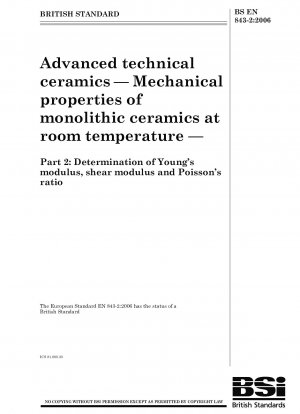BS EN 843-2:2006
Advanced technical ceramics - Mechanical properties of monolithic ceramics at room temperature - Part 2: Determination of Young’s modulus, shear modulus and Poisson’s ratio
- Standard No.
- BS EN 843-2:2006
- Release Date
- 2007
- Published By
- British Standards Institution (BSI)
- Status
- 2007-01
- Replace By
- BS EN 843-2:2007
- Latest
- BS EN 843-2:2007
- Replace
- 04/30125779 DC-2004 BS DD ENV 843-2:1996
- Scope
- This part of EN 843 specifies methods for determining the elastic moduli, specifically Young’s modulus, shear modulus and Poisson’s ratio, of advanced monolithic technical ceramics at room temperature. This European Standard prescribes four alternative methods for determining some or all of these three parameters: A The determination of Young’s modulus by static flexure of a thin beam in three- or four-point flexure. B The determination of Young’s modulus by forced longitudinal resonance, or Young’s modulus, shear modulus and Poisson’s ratio by forced flexural and torsional resonance, of a thin beam. C The determination of Young’s modulus, shear modulus and Poisson’s ratio from the time-of-flight of an ultrasonic pulse. D The determination of Young’s modulus from the fundamental natural frequency of a struck bar (impulse excitation method). All the test methods assume the use of homogeneous test pieces of linear elastic materials. NOTE 1 Not all ceramic materials are equally and linearly elastic in tension and compression, such as some porous materials and some piezoelectric materials. With the exception of Method C, the test assumes that the test piece has isotropic elastic properties. Method C may be used to determine the degree of anisotropy by testing in different orientations. NOTE 2 An ultrasonic method for dealing with anisotropic materials (ceramic matrix composites) can be found in ENV 14186 [1]. An alternative to Method D for isotropic materials using disc test pieces is given in Annex A. NOTE 3 At high porosity levels all of the methods except Method C may become inappropriate. The methods are only suitable for a maximum grain size (see EN 623-3), excluding deliberately added whiskers, of less than 10 % of the minimum dimension of the test piece. NOTE 4 The different methods given in this European Standard can produce slightly different results on the same material owing to differences between quasi-isothermal quasi-static and quasi-adiabatic dynamic conditions. In addition, the calculation routines for different methods have different origins and different potential uncertainties which have not been rigorously evaluated in producing this European Standard. Some information is given in Annex B (see also reference [2]).
BS EN 843-2:2006 Referenced Document
- EN 623-2 Advanced technical ceramics; monolithic ceramics; general and textural properties; part 2: determination of density and porosity
- EN 623-3 Advanced Technical Ceramics - Monolithic Ceramics - General and Textural Properties - Part 3: Determination of Grain Size and Size Distribution (Characterized by the Liner Intercept Method)
- EN 623-4 Advanced technical ceramics - Monolithic ceramics - General and textural properties - Part 4: Guidance on the determination of surface roughness*, 2024-04-18 Update
BS EN 843-2:2006 history
- 2007 BS EN 843-2:2007 Advanced technical ceramics - Mechanical properties of monolithic ceramics at room temperature - Determination of Young's modulus, shear modulus and Poisson's ratio
- 2007 BS EN 843-2:2006 Advanced technical ceramics - Mechanical properties of monolithic ceramics at room temperature - Part 2: Determination of Young’s modulus, shear modulus and Poisson’s ratio
